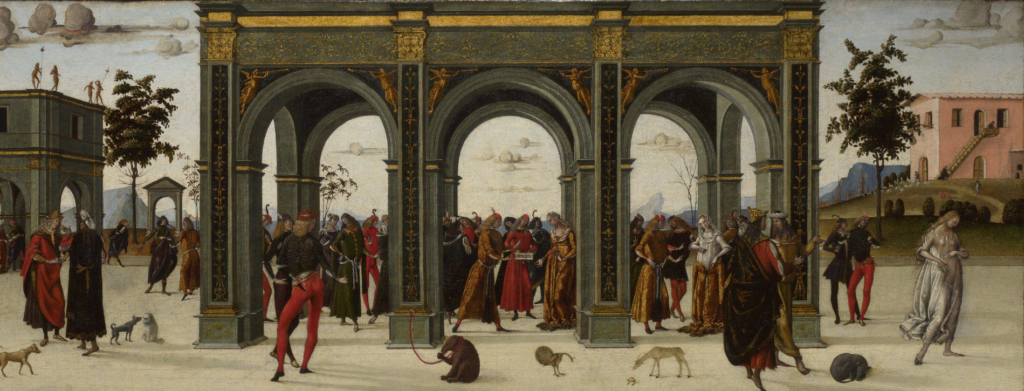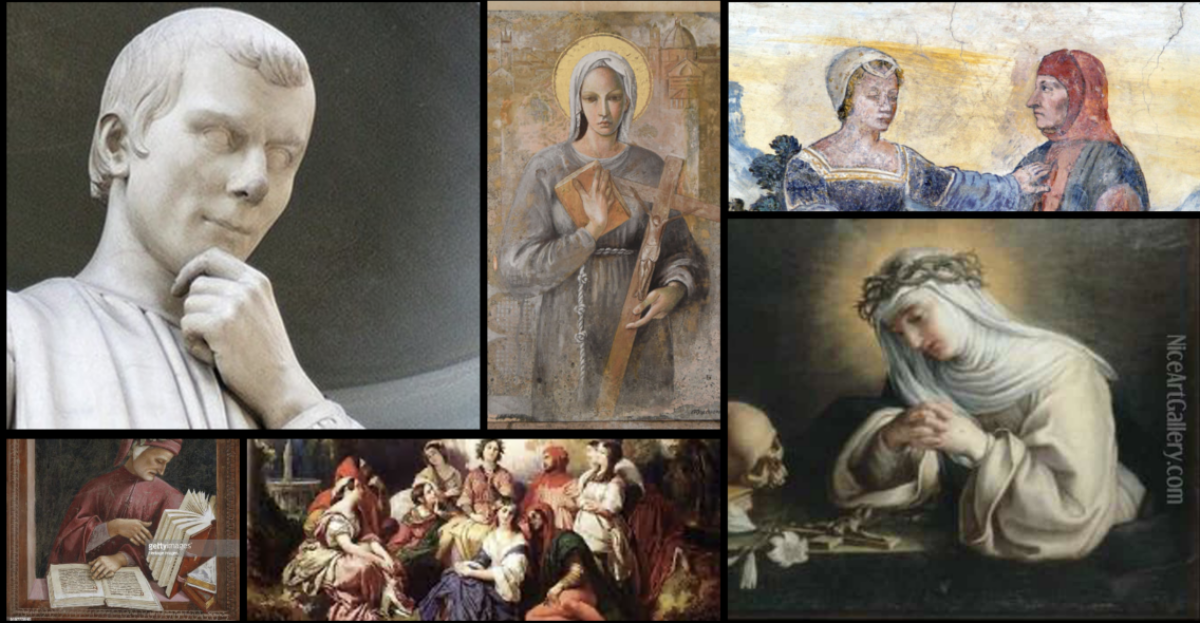
The Decameron by Giovanni Boccaccio is a collection of stories told by 10 young people, comprised of 7 women and 3 men, told over the course of 10 days after fleeing to the Italian countryside to escape the Black Plague. While it might not seem like it on the surface, each story has a greater message and is often a commentary of issues that plagued Italy at the time, such as corruption in the church and social hierarchy. What makes The Decameron so unique is the fact that many of it’s stories focus on the theme of women, particularly the role of women in society, which is something that not many writers of Boccaccio’s era were daring enough to cover.
In Day 6, story 7, Filostrato tells the story of a woman speaking out against the strict laws that often targeted women more strictly than men. In the city of Prato, the law states that a woman will be put to death and burned if she’s caught committing adultery whether it’s with someone she loves or a complete stranger. This story focuses on Madonna Filippa, who is caught cheating on her husband, Rinaldo de’ Pugliesi, with Lazzarino de’ Guazzagliotri. Instead of “falling upon them and killing them on the spot”, Rinaldo resorted to charging Filippa with adultery to have her killed. In an act of courage, Filippa showed up on the day she was summoned despite her family and friends’ attempts to dissuade her, as she would rather speak the truth and face the possible consequences than flee and live in exile. When questioned about whether or not she’s guilty of her crime, she simply responds with “True it is, Sir, that Rinaldo is my husband, and that last night he found me in the arms of Lazzarino, in whose arms for the whole-hearted love that I bear him I have ofttimes lain; nor shall I ever deny it…” She then elaborates on her admission, stating that this law is unjust as it was put in place without the consent of women, despite the fact that it only impacts women who cheat and not men. In her closing statement, she defends her actions by stating that she has “surplus” love to give, and that she deemed it better to show that love to a man who loves her as well than to “cast it to the dogs”. The crowd which has gathered around to see the trial ends up siding with Filippa, and doesn’t leave until the Podesta amends the law so that women who love the person they’re cheating with aren’t punished. In this story, Boccaccio essentially shows that women should be allowed to love whoever they please, even if it involves adultery. In my opinion, Boccaccio also shows how powerful just one woman can be, as Filippa was able to single handedly avoid persecution through her testimony, but was also able to get the law changed by getting the townspeople on her side.
On the other hand, we have the story of Griselda on day 10, the 10th story. This story focuses on the relationship between Griselda, a woman of low nobility, and Gualtieri, the Marquis of Saluzzo. Gualtieri takes Griselda as his wife despite the fact that she’s not royalty or rich, and they have an extravagant wedding. However, Gualtieri suddenly wants to test his wife’s loyalty and puts her through multiple trials. He sends away Griselda’s children (a daughter and a son), making her believe the children are dead when they’re actually in the care of someone else. He also tells her that he’s taking another woman as his wife, and again, she puts up with this behavior and encourages him to be happy with his new wife. Gualtieri then reveals that he was testing Griselda’s loyalty all along, and the story ends with them remaining happily married together. The story closes with the line “Who but Griselda had been able, with a countenance not only tearless, but cheerful, to endure the hard and unheard-of trials to which Gualtieri subjected her?”, which many interpret to mean that women are able to deal with hardship better than men.
While many commend Boccaccio for his inclusion of women, some believe that his representation of women is actually harmful. In Gender, Power, and the Female Reader, Mihoko Suzuki argues that Griselda’s story doesn’t have the message of how strong women can be, but is actually about Gualtieri’s dominance over his wife. Suzuki contrasts Griselda with other women that we’ve seen in The Decameron; while women in previous stories have been shown to disobey men (either through adultery or by outwitting them), Griselda is the complete opposite. As Suzuki puts it “And that is precisely the point: Dineo all but erases her sexuality and makes her an embodied fantasy of a constant and obedient wife…” (page 234). She then elaborates by stating that because Griselda’s personality has been watered down to that of an obedient wife and nothing else, Boccaccio is playing into the fantasy that men should have “total control and power” over their wives.
Sources:
- The story of Griselda, part I: Marriage. The National Gallery. (n.d.). Retrieved November 14, 2021, from https://www.nationalgallery.org.uk/paintings/master-of-the-story-of-griselda-the-story-of-griselda-part-i-marriage.
- Decameron web. Decameron Web | Texts. (n.d.). Day 6, story 7. Retrieved November 14, 2021, from https://www.brown.edu/Departments/Italian_Studies/dweb/texts/DecShowText.php?myID=nov0607&lang=eng.
- Decameron web. Decameron Web | Texts. (n.d.). Day 10, Story 10. Retrieved November 14, 2021, from https://www.brown.edu/Departments/Italian_Studies/dweb/texts/DecShowText.php?myID=nov1010&lang=eng.
- Suzuki, M. (1993). Gender, Power, and the Female Reader: Boccaccio’s “Decameron” and Marguerite de Navarre’s “Heptameron”. Jstor. Retrieved November 14, 2021, from https://www.jstor.org/stable/40246888.


